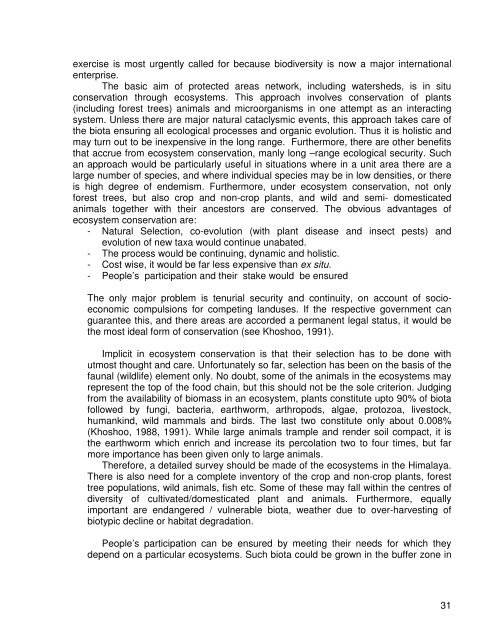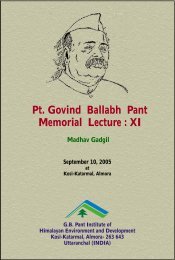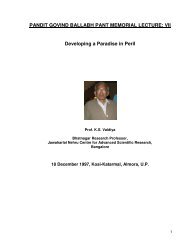Pandit Govind Ballabh Pant Memorial Lecture: II
Pandit Govind Ballabh Pant Memorial Lecture: II
Pandit Govind Ballabh Pant Memorial Lecture: II
You also want an ePaper? Increase the reach of your titles
YUMPU automatically turns print PDFs into web optimized ePapers that Google loves.
exercise is most urgently called for because biodiversity is now a major international<br />
enterprise.<br />
The basic aim of protected areas network, including watersheds, is in situ<br />
conservation through ecosystems. This approach involves conservation of plants<br />
(including forest trees) animals and microorganisms in one attempt as an interacting<br />
system. Unless there are major natural cataclysmic events, this approach takes care of<br />
the biota ensuring all ecological processes and organic evolution. Thus it is holistic and<br />
may turn out to be inexpensive in the long range. Furthermore, there are other benefits<br />
that accrue from ecosystem conservation, manly long –range ecological security. Such<br />
an approach would be particularly useful in situations where in a unit area there are a<br />
large number of species, and where individual species may be in low densities, or there<br />
is high degree of endemism. Furthermore, under ecosystem conservation, not only<br />
forest trees, but also crop and non-crop plants, and wild and semi- domesticated<br />
animals together with their ancestors are conserved. The obvious advantages of<br />
ecosystem conservation are:<br />
- Natural Selection, co-evolution (with plant disease and insect pests) and<br />
evolution of new taxa would continue unabated.<br />
- The process would be continuing, dynamic and holistic.<br />
- Cost wise, it would be far less expensive than ex situ.<br />
- People’s participation and their stake would be ensured<br />
The only major problem is tenurial security and continuity, on account of socioeconomic<br />
compulsions for competing landuses. If the respective government can<br />
guarantee this, and there areas are accorded a permanent legal status, it would be<br />
the most ideal form of conservation (see Khoshoo, 1991).<br />
Implicit in ecosystem conservation is that their selection has to be done with<br />
utmost thought and care. Unfortunately so far, selection has been on the basis of the<br />
faunal (wildlife) element only. No doubt, some of the animals in the ecosystems may<br />
represent the top of the food chain, but this should not be the sole criterion. Judging<br />
from the availability of biomass in an ecosystem, plants constitute upto 90% of biota<br />
followed by fungi, bacteria, earthworm, arthropods, algae, protozoa, livestock,<br />
humankind, wild mammals and birds. The last two constitute only about 0.008%<br />
(Khoshoo, 1988, 1991). While large animals trample and render soil compact, it is<br />
the earthworm which enrich and increase its percolation two to four times, but far<br />
more importance has been given only to large animals.<br />
Therefore, a detailed survey should be made of the ecosystems in the Himalaya.<br />
There is also need for a complete inventory of the crop and non-crop plants, forest<br />
tree populations, wild animals, fish etc. Some of these may fall within the centres of<br />
diversity of cultivated/domesticated plant and animals. Furthermore, equally<br />
important are endangered / vulnerable biota, weather due to over-harvesting of<br />
biotypic decline or habitat degradation.<br />
People’s participation can be ensured by meeting their needs for which they<br />
depend on a particular ecosystems. Such biota could be grown in the buffer zone in<br />
31











